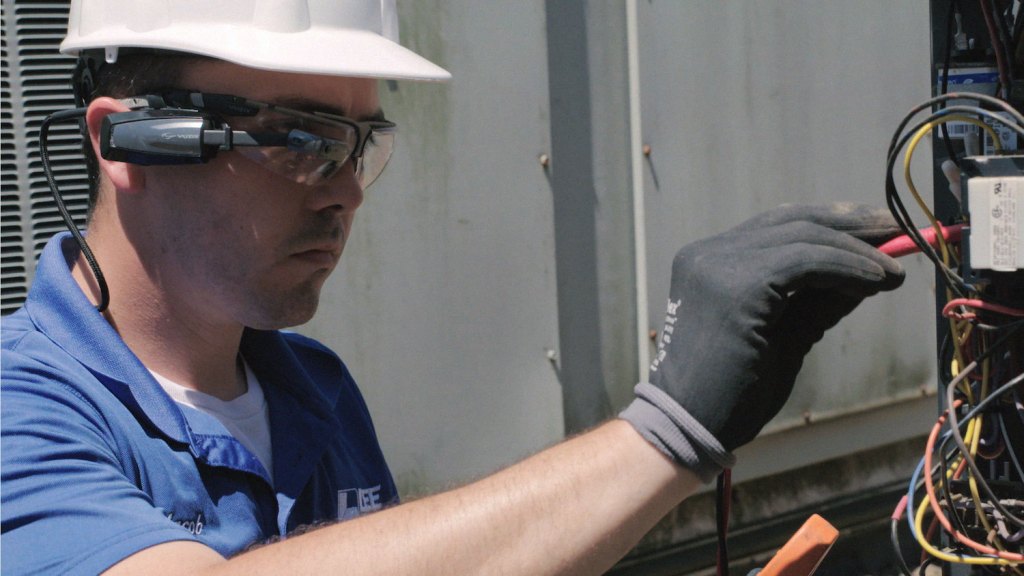Once the domain for athletes and fitness freaks, activity-tracking wearables are making their way into the workforce, specifically the construction industry.
Work wearables are “driving safety, productivity and decision-making on today’s construction jobsites,” according to Marla McIntyre, editor of Construction Executive Tech Trends. These wearables for construction workers are going to further infiltrate the construction industry next year, as they help report workplace safety and increase employee productivity.
Videos by VICE
“Data from wearables can tell a manager if a worker has fallen, has an accelerated heartbeat, or is in a restricted area as well as how productive that worker is,” said McIntyre. “At the same time, a manager can tell if productivity is lagging and find out the cause.”
According to market analysis group CCS Insight, the wearables tech industry is estimated to be worth $34 billion by 2020 and much of those these wearables will be used on the job.
A construction company could be fined less or have fewer complaints with the Occupational Safety and Health Administration with wearables onsite. They can also have lower insurance rates and help employee health and safety. “Cost may be a factor, but as more contractors use wearable technologies on the jobsite, the prices will come down,” said McIntyre.
To measure the movements of workers, the Australian wearable company dorsaVi analyzes workers’ movements with muscle activity sensors with the ViSafe, a workplace wearable which tracks how people move in real-time work situations with wireless, adhesive electrodes. The goal is to pinpoint the riskiest areas of repetitive movement that leads to injuries with data and then create solutions for a safer work environment.
For example, Transport for London, which manages London’s public transportation system, has its emergency response workers fitted with the ViSafe (which made its debut in the US this January with the Memphis-based Connect Healthcare Collaboration) to track muscle activity and movements with wearable sensors. “With work-related injuries costing $250 billion each year, we believe that US employers have an incredible prevention tool now available to them through this FDA-approved product,” said Sally Pace, co-founder of Connect Healthcare Collaboration, who said her company is going to be rolling ViSafe out to other clients throughout the US in the coming months.
“It acts like a red flag: Is this task avoidable, can we do it a different way or with a different piece of equipment?” asks Sean Watters, the emergency response unit manager of the London Underground. “But until we have that data, how can we make those decisions?”
But it isn’t all electrodes, some construction wearables include a growing number of smart glasses on the market, like the XOEye Smart Glasses, which are wirelessly connected to communicate with other workers on the team, and the Microsoft HoloLens, augmented reality goggles which allow one to interact with digital holograms—be it blueprints or full-sized 3D characters—while still to capturing your current environment. The developer edition of HoloLens is currently $3,000 but there have been no announcements for retail availability. They’ve also partnered with Volvo to help customers through the selection process of buying a new car. “We can show features, colors and options, so instead of seeing thing on a computer, you can be a part of the experience,” said Nina Larsen, director of marketing at VOLVO.
Likely to take off even more so are smart clothing pieces like the Redpoint Safety Vests, which are fluorescent yellow vests that locate workers in dangerous or hard-to-get-to locations. The vests are tracked on a map that can be viewed on a mobile app, and as soon as a worker enters a danger zone, their vest automatically flashes LED lights so other workers can spot them and quickly get them out.
Another vest that is in its early stages is the prototype created by Melbourne-based researcher Dr. Ruwini Edirisinghe, who is working on a new smart vest that can help detect a construction worker’s heat stroke, as it has sensors that measure body temperature and heart rate.
While safety vests and activity trackers are more common on job sites, smart hardhats are not. “They need to be durable enough to withstand the rigors of the jobsite and offer protection as well as be cost effective,” said McIntyre. “I believe the DAQRI Smart Helmet will be used on more jobsites in 2017.”
The augmented reality helmet digitally projects a worker’s instructions on a clear plastic visor that pulls down in front of their forehead. It shows things like the temperature inside of a water boiler as you stand before it, or the electricity on a construction site before it’s actually installed. It also has a navigation camera, can record video and take photos. “Onsite field workers or service contractors can take advantage of the technology to show a problem to someone in the office,” said McIntyre.
But the main issue is to keep workers working, as well as respond to the needs of millennials. “As younger workers enter the construction industry, they will demand more use of technologies available,” she said. “The construction industry needs more workers and the wearable technologies can keep older workers on the job longer.”




